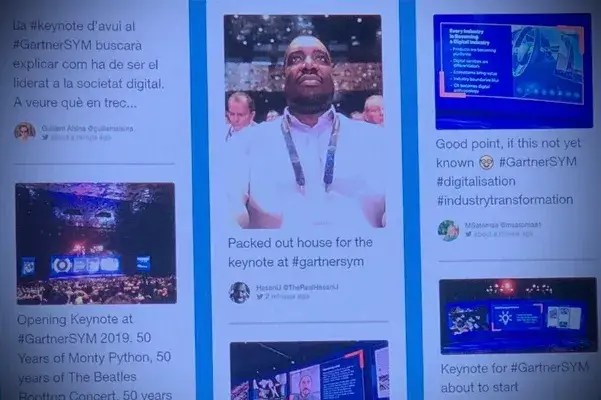November 2019 saw nearly 8000 technology leaders from around Europe and Africa descend on Barcelona for the annual technology strategy extravaganza hosted by Gartner – the research and advisory organisation famous for its Magic Quadrants.
The 5-day Gartner IT Symposium/Xpo event provides research into technology trends, inspiration on strategic direction and insights into the broader opportunities available to those of us whose first business language is technology.
Through the power of Twitter, I even managed to get myself a starring role on stage!

Everyone likes a top 10
At the Gartner IT Symposium/Xpo 2019, this was no different. Amongst the most eagerly awaited sessions was Gartner’s Top Strategic Predictions for 2020 and beyond. Without breaching copyright, the predictions from the main theme revolved around the amount of personalised data that will be available in coming years. Aligning this with the ever-evolving power of artificial intelligence technologies and the increasing attention given to cyber security, there are potentially many concerning scenarios that society will need to wrestle with.
The scenarios I refer to are not the dystopian futures of the singularity machine that eradicates the parasite that it deems humanity to be. There are many simpler and more easily imaginable situations that require our thought.
But what is this personalisation I speak of? Today, the amount of information that is collected about us is continuously growing. The most common is our web usage. Most people are very aware that every click across the web is being tracked somewhere. We are also very comfortable that our telephony data is also tracked – thus making our movements trackable and predictable. What about our spending habits? Yep those have been tracked for years. But that is all about our external manifestations. What about our internal health metrics? Those are being captured more and more. What about body language, mood detection, attraction and other bits of information that have traditionally been off-limits for technologist? Those are also being captured increasingly more often too.

Back to the future
None of the information I have described thus far is futuristic. They all exist today and are being used to provide services and sell products to us. In most cases, organisations only have subsets of this information – thus avoiding inevitable privacy concerns. But these predictions indicate that, over the coming years, these hubs of data are likely to come closer and closer together. One the one hand, this may provide us with even more powerful and personalised services. But at what cost?
Pleasingly, the tone of the presentation was geared towards far nobler goals, like enabling more disabled workers to successfully enter the workforce, increased productivity from augmented intelligence (a return from the previous year) and citizen developers (something also being pushed by Microsoft). In a nutshell, using these capabilities for the good of our customers, employees and society in general. Noble goals indeed.
What is the takeaway for me? At Simply Business, we have fantastic technologists who have the skills to exploit many of these technologies. Whether it be ensuring our customers’ data is safe, providing the best products that meet their needs in increasingly automated ways, or predicting what insights will be relevant to help their businesses. However, all of that is not as important as the values that we overlay our capabilities with. This is what Gartner was not only predicting, but encouraging.
Ready to start your career at Simply Business?
Want to know more about what it’s like to work in tech at Simply Business? Read about our approach to tech, then check out our current vacancies.
We create this content for general information purposes and it should not be taken as advice. Always take professional advice. Read our full disclaimer